Fanless Computer & Industrial Fanless PCs
Tekdis UK's Industrial Fanless Computers, Fanless PCs, and DIN-Rail Embedded Systems are ultimate solution for rugged and demanding industrial environments. Axiomtek Fanless Edge or Rugged AI Systems and Nexcom Cabinet Mount Fanless PC, our products are built for performance and reliability. These Fanless PCs are also energy-efficient, consuming less power, and promoting sustainability. Experience the benefits of fanless design, where silent operation and low maintenance costs are the norm. Eliminating cooling fans ensures protection against dust and debris ingress, making these systems ideal for harsh conditions. They are perfect for industries like transportation, manufacturing, mining, and energy, where extreme temperatures and vibrations are common.
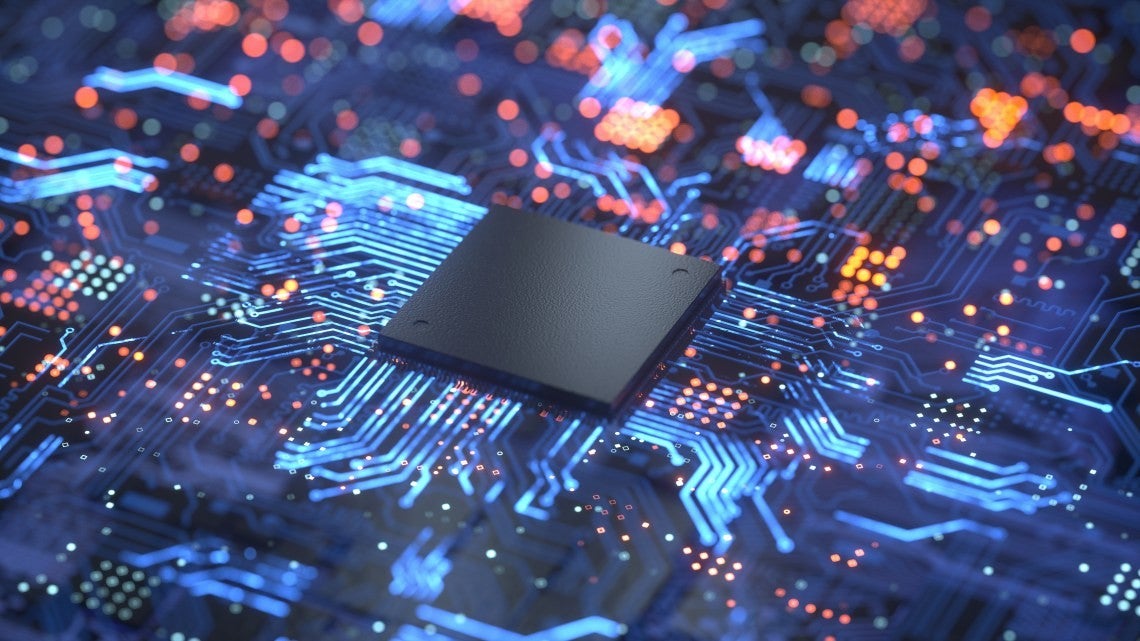
-
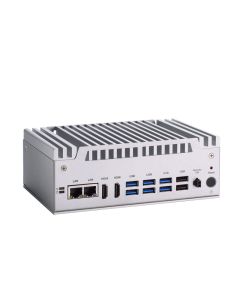
 eBOX570 Fanless Embedded System with 13th Gen
eBOX570 Fanless Embedded System with 13th GenFanless Embedded System with 13th Gen Intel Core i7/i5/Celeron Processor, 2 HDMI, 1 DisplayPort++, 2 LANs, 8 USB, 2 COM, and 12 VDC
Key Features:
- 13th gen Intel Core processor (Raptor Lake P)
- Fanless design with operating temperature from -20°C to 60°C
- 1 DDR4 SO-DIMM for up to 32GB of memory
- Supports the USB power on/off control function
- Supports high-speed NVMe storage (M.2 Key M 2280)
- Supports Intel® vPro and TPM 2.0
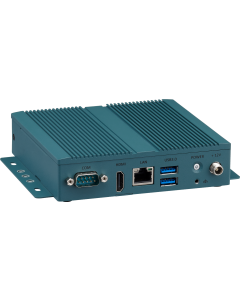
 Neu-X60 Palm-sized Fanless Edge Computer
Neu-X60 Palm-sized Fanless Edge ComputerIntel N50 processor, Palm-sized Fanless Edge Computing System
Key Features:
-
Intel® Processor N50
-
Small footprint in Palm size
-
Pre-installed 4G memory
-
Pre-installed 64G M.2 storage
-
Support 1x Intel I226-V 2.5GbE LAN
-
1x HDMI, 1x RS232/422/485, 2x USB3.2
-
1x mini PCIe full size for optional wireless module
-
Great value for indoor applications
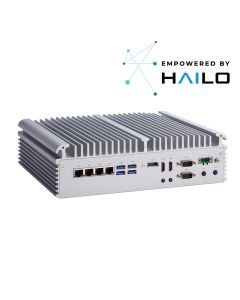 eBOX671A Fanless Embedded System with LGA1200 Socket 11th/10th Gen
eBOX671A Fanless Embedded System with LGA1200 Socket 11th/10th GenWith LGA1200 Socket 11th/10th Gen Intel Xeon, Core i9/i7/i5/i3 or Celeron Processor, Intel W480E, 2 HDMI, DisplayPort, 6 USB, 4 LAN, and 9 to 48 VDC
Key Features:
- LGA1200 11th/10th gen Intel® Xeon®, Core™ i9/i7/i5/i3 or Celeron® with Intel® W480E chipset (Comet Lake-S)
- 4 GbE LAN with optional PoE supported
- Dual 2.5" SATA HDD drive bays with RAID 0 & 1
- 2 HDMI and 1 DisplayPort for triple-view
- -40°C to +70°C wide range operation temperature
- Wide range power input from 9 to 48 VDC
- Flexible I/O window supported via mPCIe modules
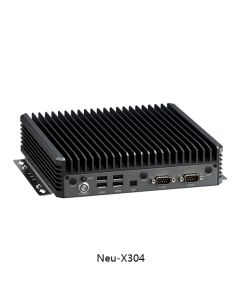
 Neu-X304 Edge Computer System 13/12th Gen CPU
Neu-X304 Edge Computer System 13/12th Gen CPUUnleash the potential of multiple AI and edge applications with the Neu-X304
Key Features:
- 13/12th Gen Intel® Core™ i9/i7/i5/i3 processors, up to 35W
- Dual channel DDR5 SO-DIMM, max up to 64GB
- Support 3 x HDMI 2.0 output, 4K@60Hz
- Dual Intel® LAN ports
- Rich Interface : 2 x COM ports, 8 x USB port, Mic-in, Line-out
- TPM 2.0 onboard
- Support Intel® AMT technology (Q670E only)
- Multiple expansion slots: M.2 2280 Key M for storage, M. 2 2230 Key E for Wi-Fi module,
- M.2 3052 Key B for LTE/5G module
- Power Input:12V DC or 12~24V DC (Q670E only)
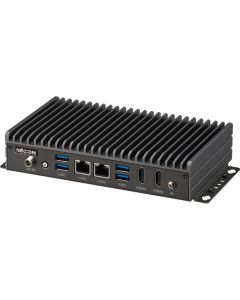
 Neu-X102-N97 Edge Computing System Powered by Intel N97
Neu-X102-N97 Edge Computing System Powered by Intel N97Edge Computing System Powered by Intel® Processor N97 (Alder Lake-N)
Key Features:
- Intel® processors N97 (Alder Lake-N), Intel 7 process
- Slim compact chassis and fanless design
- 1 x DDR4 SO-DIMM socket, max up to 16GB
- Support 2 x HDMI 1.4b output, 4K@30Hz
- TPM 2.0 onboard design for security
- Richful I/O connectivity: 2 x 2.5GbE LAN, 4 x USB 3.2 Gen2
- 1 x M.2 2242 Key M for supporting PCIe & SATA storage device
- 1 x mini-PCIe slot supports Wi-Fi and LTE module
- Support power input 12 VDC
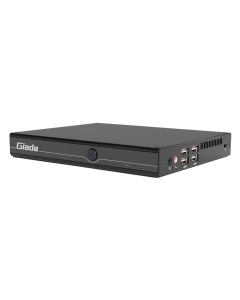 F108D Booksize Fanless Signage Player 4K Display
F108D Booksize Fanless Signage Player 4K DisplayCompact, fanless Intel Alder Lake-N powered PC for digital signage and kiosks. Features versatile I/O ports, high-quality graphics, and reliable operation in mission-critical scenarios.
Key Features:
- Powered by Intel® Alder Lake-N processors (6-15W) for low-power efficiency.
- Book-size design tailored for digital signage and kiosk applications.
- Rich I/O ports, including dual COM ports, 6 USB Type-A, and dual LAN ports.
- Easily integrates into vending machines, self-service kiosks, and check-in kiosks.
- Intel® UHD Graphics with DP and two HDMI ports supporting resolutions up to 4096 x 2160@60Hz.
- Fanless design with passive thermal cooling for noise-free and dustproof operation.
- Ideal for mission-critical applications with reduced failure rates.
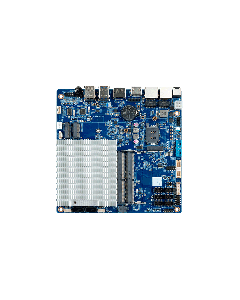 IB4-271 Long Life Cycle Thin Mini-ITX Motherboard
IB4-271 Long Life Cycle Thin Mini-ITX MotherboardGiada IB4-271, a slim Mini-ITX motherboard featuring Elkhart Lake Celeron J6412 with a 10W TDP, is aligned with Intel® IOTG's roadmap, ensuring a 7+ years lifespan and notable performance enhancements.
Key Features:
- Elkhart Lake platform delivers up to 1.7x improvement in single-thread and 1.5x improvement in multi-thread performance.
- Three display outputs (DP, HDMI, LVDS) with 4K support via HDMI (4096 x 2160 @60 Hz) and DP (4096 x 2160 @60 Hz) powered by Intel® UHD Graphics.
- Wi-Fi 5/6 support for high-speed data transfer and seamless connectivity to various peripherals.
- Fanless design with a passive thermal cooling system reduces failure rates, ensuring noise-free and dustproof operation for mission-critical applications.
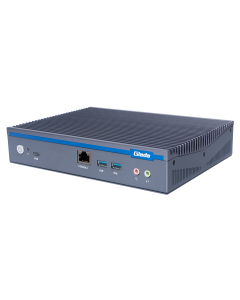 RN28 Fanless 12th Gen Network Appliance
RN28 Fanless 12th Gen Network ApplianceDesigned for efficiency and connectivity, the RN28 features Intel Alder Lake-N processors, robust Gigabit and PoE support, and a fanless design for noise-sensitive environments.
Key Features:
- Powered by Intel Alder Lake-N processors on the Intel 7 process, RN28 offers superior processing power with energy efficiency.
- Processor N100 with 4 Cores and 4 threads, TDP under 15W.
- Robust connectivity with two Gigabit RJ-45 (BYPASS pair on Lan 1-2) and four Gigabit RJ-45 supporting PoE for fast, direct connections.
- Wireless flexibility with support for Wi-Fi 5/6/6E.
- Four RJ45 ports supporting Power over Ethernet (PoE), each capable of delivering up to 30W.
- Simplified network setup by combining data connectivity and power delivery.
- Fanless design is ideal for noise-sensitive environments.
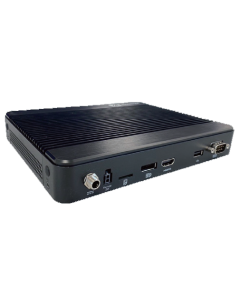 DSP501-A Digital Signage Player w/ Hailo-8 SoC
DSP501-A Digital Signage Player w/ Hailo-8 SoCDigital Signage Player with Intel® Celeron® Processor 4305UE, DisplayPort++, HDMI, 5 USB, 2 LAN, Hailo-8 SoC
Key Features:
- Intel Celeron processor 4305UE
- 2 DDR4-2400 SO-DIMM for up to 32GB of memory
- 1 DisplayPort++ and 1 HDMI 2.0
- 5 USB, 1 GbE LAN, 2.5GbE LAN
- 1 M.2 Key E 2230 for Wi-Fi/Bluetooth
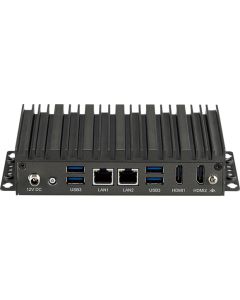 Neu-X102-N50 Fanless Edge Computing System Powered by Intel N50
Neu-X102-N50 Fanless Edge Computing System Powered by Intel N50Powered by Intel Processor N50 (Alder Lake-N), slim compact chassis and fanless design
Key Features:
- Intel processors N50 (Alder Lake-N), Intel 7 process
- Slim compact chassis and fanless design
- 1 x DDR4 SO-DIMM socket, max up to 16GB
- Support 2 x HDMI 1.4b output, 4K@30Hz
- TPM 2.0 onboard design for security
- Richful I/O connectivity: 2 x 2.5GbE LAN, 4 x USB 3.2 Gen2
- 1 x M.2 2242 Key M for supporting PCIe & SATA storage device
- 1 x mini-PCIe slot supports Wi-Fi and LTE module
- Support power input 12 VDC
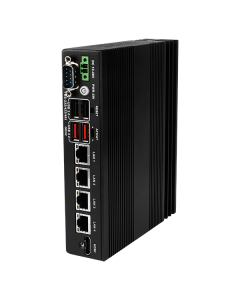 DRPC-124-EHL Fanless DIN-Rail Embedded System
DRPC-124-EHL Fanless DIN-Rail Embedded SystemDiscover industrial computing excellence with the fanless DRPC-124-EHL Embedded System, featuring Intel Celeron power, four GbE LAN ports, and a compact design.
Key Features:
-
Compact Industrial Mini PC
-
Fanless system
-
Intel Celeron J6412 2.0 GHz (up to 2.6 GHz, quad-core, TDP 10W)
-
Four GbE LAN
-
CE/FCC compliant
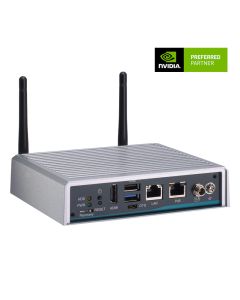 AIE100-ONA Fanless Edge AI System with NVIDIA Jetson Orin Nano SoM
AIE100-ONA Fanless Edge AI System with NVIDIA Jetson Orin Nano SoMAxiomtek AIE100-ONA Fanless NVIDIA® Jetson Orin™ Nano SoM, 1 HDMI, 1 GbE LAN, 1 GbE PoE, and 2 USB, Allxon Remote Management
Key Features:
- NVIDIA® Jetson Orin™ Nano, up to 1024-core NVIDIA Ampere GPU
- High AI computing performance for GPU-accelerated processing
- Ideal for edge AI smart city applications
- Supports one 15W GbE PoE for camera
- Wide operating temperature from -20°C to +50°C
- JetPack supported
- Supports 24/7 secure remote monitoring, control, and OTA deployment empowered by Allxon
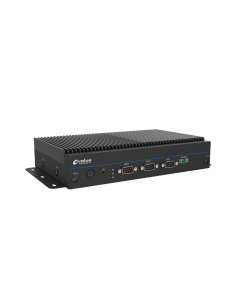 EMS-TGL Fanless Rugged Embedded System 11th Gen
EMS-TGL Fanless Rugged Embedded System 11th Gen11th Gen. Core i7/i5/i3 BGA Processor, Rich I/O, support 5G module, fanless operation temperature -40°C ~ 70°C
Key Features:
- On board 11th Gen. Intel Core i7/i5/i3 BGA Processor
- 2x 260-pin SODIMM socket Max. up to 64GB DDR4 3200MT/s
- Rich I/O, 4-USB3.1, 1-DP, 1-HDMI, 2-COM, 2-LAN, 1-8bit GPIO.
- Support 5G (Sub-6G) module, M.2 NVMe SSD Gen. III x 4, HDMI 2.0b (4K @ 60Hz), LAN 2.5G BaseTx GbE
- Fanless operation temperature from -40°C ~ 70°C (WT) / 0°C ~ 70°C (ST)
- CE, FCC Class B, IP50
- Wide range DC power input from +9~32V
- Support HW TPM 2.0
- Support vPro
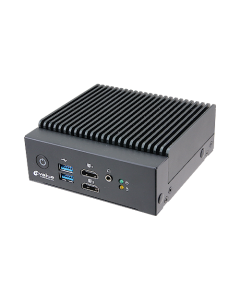 NUC-APL-SLIM Fanless NUC Slim System J3455/N3350
NUC-APL-SLIM Fanless NUC Slim System J3455/N3350Intel Apollo Lake J3455/N3350 Up to 8GB DDR3
Key Features:
- Onboard Intel Celeron Processor J3455/N3350
- Single DRAM Socket, Max. Up to 8GB DDR3 1866MHz
- Rich I/O, 1 x COM, 2 x HDMI, 2 x LAN, 4 x USB3.0, 1 x Audio, 2 x Antennal Mounting
- Expansion Slot, M.2 Key-B, M.2 Key-E
- Fanless Operating from 0°C ~ 50°C
- DC Power Input +12V
- Compact Size, 115mm x 111mm x 45mm
- Supports VESA/Din-Rail Kit
- TPM 2.0 (Factory Option)
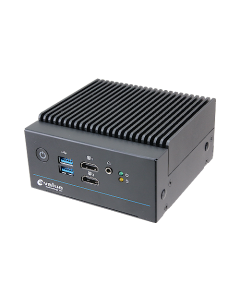 NUC-APL Fanless NUC System J3455/N3350
NUC-APL Fanless NUC System J3455/N3350Intel Apollo Lake Celeron Processor J3455/N3350 Up to 8GB DDR3
Key Features:
- Onboard Intel Celeron Processor J3455/N3350
- Single DRAM Socket, Max. Up to 8GB DDR3 1866MHz
- Rich I/O, 2 x COM, 2 x LAN, 4 x USB3.0, 1 x Audio, 2 x Antennal Mounting
- Triple Display, 2 x HDMI, 1 x DP (DVI-I/VGA Factory Option)
- Expansion Slot, M.2 Key-B, M.2 Key-E
- Fanless Operating from 0°C ~ 60°C
- DC Power Input +12V
- Compact Size, 115mm x 111mm x 58mm
- Supports VESA/Din-Rail Kit
- TPM 2.0 (Factory Option)
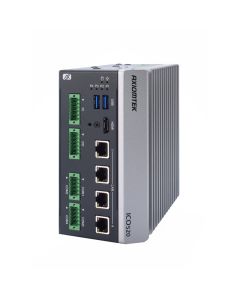 ICO520 Fanless Embedded System 12th Gen i7/i5/i3
ICO520 Fanless Embedded System 12th Gen i7/i5/i3Axiomtek ICO520 DIN-Rail Fanless Embedded-System 12th-Gen Intel®-Core™ 4x2.5GbE, 4xIsolated-COM, Isolated DIO (8-in/8-out)
Key Features:
- High performance with fanless and DIN-rail design
- 12th Gen Intel® Core™ i7/i5/i3 or Celeron® processor (Alder Lake-P)
- 4 isolated COM, isolated DIO (8-in/8-out), 4 2.5 GbE LAN
- Wide operating temperature range from -40°C to +70°C
- 9 to 36 VDC, typical 12-24V power input with OVP, UVP, OCP, RPP
- Supports TPM 2.0
- Supports cold boot at -40°C
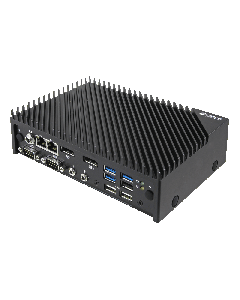 ACS10-TGU 11th Gen Intel Fanless Compact System
ACS10-TGU 11th Gen Intel Fanless Compact SystemCompact and easy to set up, highly expandable I/O interfaces and flexible storage design, and supports high-resolution graphics
Key Features:
- 11th Gen Intel Core i5/i3 Tiger Lake-UP3 Processor
- Intel Iris Xe/ UHD Graphics Engine
- 1-260-pin DDR4 3200MHz SO-DIMM, Supports Up to 32GB
- 2-Gigabit Ethernet, 1 x 2.5GbE, 1 x 1GbE
- 2-COM Port (RS-232/422/485 & RS-232)
- 2-Audio Jack (Line-Out & Mic-In)
- 2-Storage (M.2 Key-M NVMe & M.2 Key-B SATA)
- 2-Expansion Slot (M.2 Key-E, Key-B)
- 6-USB Port (3-USB 3.2 & 3-USB 2.0)
- CE, FCC Class A, UKCA
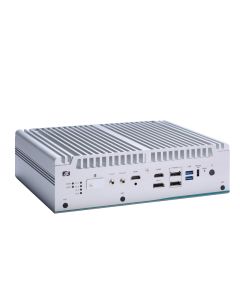 eBOX671B Fanless Embedded System with 13th/12th Gen
eBOX671B Fanless Embedded System with 13th/12th GeneBOX671B Fanless Embedded System 13th/12th Gen Intel® Core™ 2.5GbE M.2 Key M&E&B USB3.2
Key Features:
- 13th/12th Gen Intel Core i9/i7/i5/i3 and Celeron
- processors with Intel R680E chipset (Alder Lake S)
- Dual DDR5 SO-DIMM for up to 64GB of memory
- 4 LAN with optional PoE supported
- Dual 2.5" SATA HDD drive bays with RAID 0 & 1
- Supports MXM 3.1 Type A, up to 5 display outputs
- -40 °C to +65 °C wide operating temperatures
- Wide range power input from 9 to 36 VDC
- Flexible I/O window supported via mPCIe modules
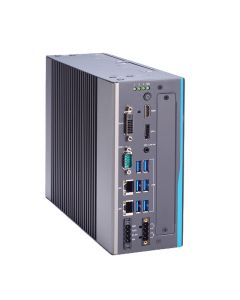 IPC960A Fanless Industrial System 12th Gen
IPC960A Fanless Industrial System 12th GenLGA1700 Socket 12th Gen Intel Core i7/i5/i3 or Celeron Processor, Intel H610E/Q670E, and Front-access I/O
Key Features:
- Fanless embedded system
- Optional extension system I/O window
- Optional 5G network (Q670E)
- USB power on/off control via BIOS setting
- Intelligent power management - ACC ignition
- EN 61000-6-2 certified
- Supports Intel RST
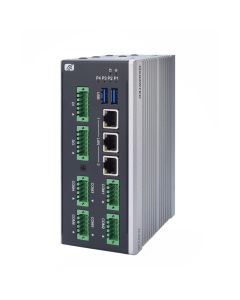 ICO330 DIN-Rail Fanless Embedded System
ICO330 DIN-Rail Fanless Embedded SystemIntel Atom 3 x 2.5GbE LAN Isolated COM & DIO Fanless System
Key Features:
- Cost-effective with fanless design
- Intel Atom® x6212RE or x6414RE processor
- 6 isolated COM, isolated DIO (8-in/8-out), 3 2.5 GbE LAN
- Wide operating temperature range from -40°C to +70°C
- 9 to 36 VDC, typical 12-24V power input with OVP, UVP, OCP, RPP
- Supports TPM 2.0
- Supports cold boot at -40°C
Fanless PCs
Fanless PCs are compact and noiseless computer systems that do not rely on internal cooling fans. Rather, they utilise passive cooling methods like heatsinks or heat pipes to effectively dissipate heat. Fanless PCs are well-suited for various industrial applications, as their durable designs shield them from dust, debris, and harsh environmental conditions. Because of this, fanless PCs have been commonly used in industries such as manufacturing, automation, transportation, and outdoor industries. They are also highly sought after in various vocations where reliably silent PC operation is crucial. Such sectors include broadcasting & media, healthcare, libraries, financial institutions, call centres, research & development labs, and home offices. A fanless PC ultimately offers a stable performance, reduces maintenance needs, and ensures continuous and uninterrupted operation in demanding industrial environments.
Fanless Computer & PCs Types
There is a wide scope of options when it comes to fanless devices. Depending on your requirements, you may wish to consider:
- Industrial Fanless Box PC is the term to describe any computer without a fan and without a screen (the label “box PC” can be used interchangeably with fanless PCs and embedded PCs). Industrial fanless box PCs are often compact, rugged, and enclosed in a box-shaped chassis. They are commonly used in industrial settings where space is limited and reliable performance is crucial, and typically have designs that include ridges that are included to create more surface area so as to dissipate heat, and/or antennas, which can serve the same function while simultaneously boosting Wi-Fi signal power.
- Industrial Fanless Tablets are made to last. Foregoing the fans and other mechanical components that make a device easily breakable, industrial fanless tablets can withstand standard shocks and drops while still providing you with a sturdy, functioning device in harsh work environments. It’s worth noting that industrial fanless tablets generally have a lower computing power than some other devices, though this is by design, as it makes it easier for the device to dissipate heat via a stable heat management solution.
- Industrial Fanless Panel PCs is a rugged and silent computing solution designed for industrial environments. In the past, these panel computers were commonly interconnected through COM lines, though the more modern designs usually feature a bezel on the outer edge, allowing it to fit snugly into a cut-out area on a control panel with surrounding workspace. These PCs serve as dedicated human-machine interfaces (HMIs) for operators, enabling seamless monitoring and control of industrial processes. With a fanless design, they offer enhanced reliability, reduced maintenance, and efficient heat management. Industrial Fanless Panel PCs are ideal for control rooms, manufacturing floors, and automation systems, ensuring smooth and uninterrupted operations.
- Industrial Fanless All-in-One PCs are complete computing solutions with built-in displays and fanless designs. These PCs provide a modern aesthetic and are ideal for industrial settings where reliable and maintenance-friendly computing solutions are required. Some are built for continuous 24/7 operation, and they are ideal for any business that prioritises space-saving. Most feature a streamlined bezel with minmises seams and ridges, which helps provide a sleek and contemporary appearance while facilitating effortless cleaning.
- Industrial Fanless Stainless Steel PCs (with IP65 Rating or Above) are resistant to dust, water, and most other other environmental contaminants. Housed in stainless steel that can resist corrosion and rust, these computers are designed to operate in the most hostile conditions; in fact, they typically come with an IP65 rating (sometimes higher) which means they are also considerably waterproof, meaning you can even use them in heavy rain.
- Rugged Fanless Computers are built to withstand shock, vibrations, and extreme temperatures - including humidity, freezing frost, or blazing sun. They are commonly used in outdoor, military, transportation, and mining applications where standard computers may fail due to harsh conditions. Rugged fanless computers usually come equipped with a MIL-STD-810 vibration/shock rating and an IP65 housing, along with intermittent internal heating components.
The Pros of Investing in a Fanless Computer
- Silent Operation: Fanless PCs produce little to no noise, making them suitable for noise-sensitive environments.
- Improved Reliability: Without moving parts like fans, there are fewer components prone to failure, leading to increased reliability and longer lifespan.
- Dust and Debris Resistance: Fanless PCs are less likely to accumulate dust and debris, reducing the need for regular maintenance.
- Energy Efficiency: They consume less power than traditional PCs with fans, leading to reduced energy costs.
- Compactability: Fanless PCs often have space-saving designs, making them ideal for constrained environments.
The Cons of Investing in a Fanless Computer
- Heat management: Fanless PCs may require larger heatsinks or passive cooling solutions to dissipate heat effectively, which can limit performance in some cases.
- Price: Fanless PCs can be more expensive than standard PCs due to their specialised design and components.
- Performance limitations: In high-performance computing tasks, fanless PCs may not match the processing power of systems with active cooling.
How Do Fanless PCs Work?
Rather than using fans to cool its internal components, a fanless computer relies on heat sinks to transfer heat away from the heat-generating parts (such as the CPU and silicon chips) to the aluminium body of the computer. This aluminium body acts as a large heat sink, dissipating the heat and keeping the PC cool. Some high-end industrial fanless PC brands may also include fins on top of their aluminium cases to enhance heat transfer from the computer's outer casing to the surrounding air. Heat sinks effectively manage the system's temperature by absorbing heat generated by components and transferring it to the cooler aluminium enclosure. The outer casing is then cooled by the surrounding air, ensuring optimal temperature regulation without the need for fans.
Features of Fanless Computer & PCs
- Quiet Performance: Fanless computers operate noiselessly, creating a peaceful and distraction-free environment.
- Shock and Vibration Resistance: Fanless PCs are designed to withstand shocks and vibrations, making them ideal for rugged and challenging environments.
- Low Power Consumption: Fanless PCs consume less power, leading to energy savings and reduced operating costs.
- Enhanced Reliability: The absence of moving parts like fans increases the reliability and durability of fanless computers, reducing the risk of component failures.
- Dust and Debris Resistance: With no internal fans, fanless computers are less prone to dust and debris accumulation, ensuring smoother and cleaner operation.
Why Choose Tekdis?
At Tekdis, we provide a diverse range of industrial computers in various form factors, and we can customise comprehensive solutions that are tailored to meet any customer’s specific needs. Beyond fanless PCs, we also provide a wide range of tech solutions tailored to the industrial, medical, and automotive sectors. Being a technology-focused company, Tekdis constantly surveys the market to identify emerging needs and incorporates new products aligned with current trends and cutting-edge technologies. Tekdis takes great pride in its exceptional customer service and retention by offering extensive pre and post-sales support.
You can browse the wide range of Tekdis Fanless Computers & Fanless PCs here, and you can see the vast range of other Tekdis products here. Can’t find what you’re looking for? Don’t hesitate to get in touch with us directly via our Contact Us page, and one of our friendly staff members will help you find what you’re looking for.
FAQs
Are fanless PCs any good?
Yes, fanless PCs can be an excellent choice for specific use cases, providing an ideal solution for noise-sensitive environments, industrial settings, and outdoor environments.
Do fanless computers overheat?
As long as they are used within their specified operating conditions and in suitable environments, fanless computers should not overheat. Fanless computers are designed to handle heat without the use of internal fans, using passive cooling methods like heat sinks or heat pipes to dissipate heat effectively.
What are some benefits to fanless PCs?
Some benefits of fanless PCs include silent operation, improved reliability, and durability due to fewer moving parts, resistance to dust and debris, energy efficiency leading to lower power consumption, and their suitability for space-constrained environments.
Does fan speed matter on PC?
Simply put: yes. Proper fan speed helps maintain optimal temperature levels for components, preventing overheating and potential damage. Fan speed control is crucial in balancing cooling performance and noise levels. Modern systems often employ fan speed management to adapt cooling based on the workload and thermal conditions.
Is a fanless mini PC better than a fan PC?
The choice between a fanless mini PC and a fan-equipped PC depends on specific requirements and use cases. Fanless mini PCs excel in silent operation, reliability, and reduced maintenance needs. On the other hand, fan-equipped PCs can handle more demanding computing tasks and offer greater performance potential. Before you make your choice, consider both the intended use of the device, as well as the environment you’ll be using it in.

Loading...